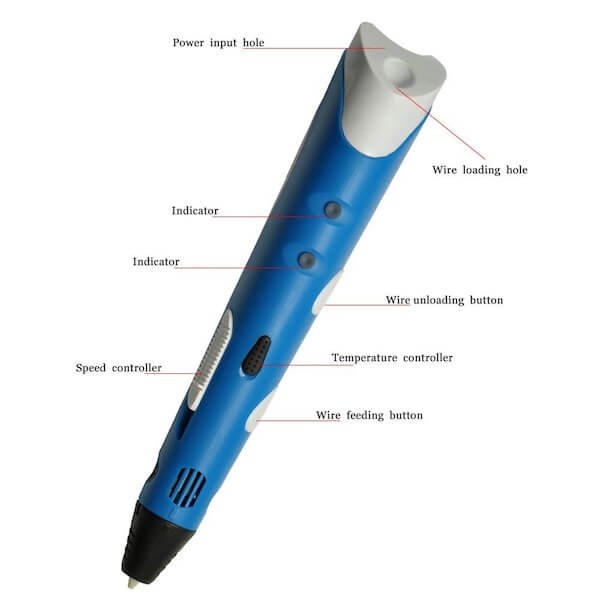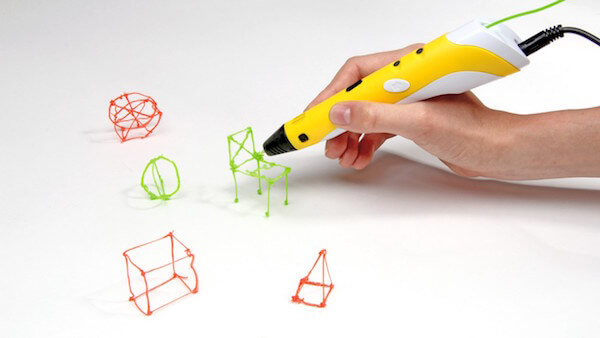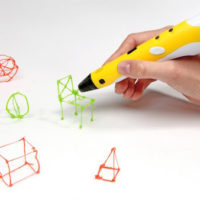Any artists or illustrator has once come across the idea of weaving his or her pen in air as opposed to on paper in order to bring an idea to life. With the recent advancements in 3D printing, that is all possible now. Just like the average 3D printer, the 3D pen is the new hype. With a lengthy body, the contraption is mostly designed to be held like a pen, allowing you to ooze out molten plastic which harden instantly enough to form free standing structures. And just like that, you can actually start building and producing rather than just drawing. Read on for more on 3D pens and their applications.
The principle is the same behind the technology. Like a 3D printer, the pen is fed plastic threads which the machinery inside melts and allows you to squeeze out of the tip and create anything you can imagine. Threads come in different colors and lengths and even in materials. The two most common materials are the ABS and PLA with their respective pros and cons. Let’s talk about the different details first.
The 3D Pen Body
The back of the pen contains a filament input which receives the plastic thread. This is also where the power socket is located for charging. Depending on the design, a light based indicator will tell you how warm the plastic is, once it is at the right temperature you can start drawing.
The pen usually has a few buttons or dials, no matter what the make and they are meant for speed or temperature control and other basic functions you may need while drawing. The tip will typically have a heating housing so be careful when handling. The actual tip which will extrude the material will be adjustable or changeable. Changing it allows for your choice of diameter which will leave thicker or thinner strands when you draw.

The 3D Pen Plastic
The plastic is available in two types, namely ABS and PLA. These both are regular plastics with the following differences. The ABS filament is stronger, flexible and temperature resistant. Because of its petroleum origin, its burning has a hot plastic smell when drawing. The plastic melts at ~360 (Fahrenheit) and working temperature is ~440. The PLA on the other hand is made from organic and vegetation giving out a semi-sweet odor during operation. It’s a bit more rigid, with lesser strength and a sensitivity to moisture. The color range is greater in PLA with a glossy effect because of its texture. A more detailed comparison of ABS vs PLA can be found here.
The 3D Pen Package
Most kits whether purchased online or at a store, contain some filament by default. Usually there is a complete set of filaments in black, and one of equal size, the colors divided amongst the total rods. The pen is obviously included with an extra battery in most cases. An instruction manual will be provided surely. As the equipment has to deal with molten plastic and overheated metallic instruments, caution should be exercised when allowing children to play with it.
And Now, The Art!
The 3D pens application are well beyond the regular drawing in air. Sure you can create a little Eiffel Tower for your mantel but artists and enthusiasts around the world have already taken to using the technology every way they can. Read on to find out more.

3D Design
Everything from a handwritten 3D slogan to a bank account signature can be created using the technology and designers are already using the technology to come up with design-based text that follows no pre-defined font face but looks extraordinary. The ability to feed a new filament in allows you to start with black and then top of it off with any other color off choice, so if you’re looking to create on a larger scale, you can do it with ease.
Prototyping
With the advent of such a compact 3D extrusion machine, drawing up a prototype does not need elaborate software or hours of developing a scaled model in the software. In order to show someone a model of the real thing, a freehand prototype can be created in front of the customer’s eyes while talking.
3D Scanning
If you’re done creating a prototype as mentioned earlier, load your model into a 3D scanner and allow the scanner to produce a soft replica as well as generate point cloud data which you can later edit instead of having to draw the whole thing from scratch. If a model needs to be updated, you can add to it by the same method you used when creating the model and upload it again.
Partner off with a 3D Printer
Once a printer is done printing a 3D model, you can use the pen to make emends, add more material where it may be needed. Even if you’ve chipped a model, you can use the pen to add some molten material and smooth the model out.
Personal use
If you don’t work for a NASA contractor and won’t be creating many prototypes, or you don’t have the professional needs that would require point cloud data or 3D scanning, then the simplest use of the 3D pen is personal use. Children have taken to creating mobile phone covers, refrigerator magnet cases and even decorations for their shoes and clothes. But all this just goes to say, the creative potential is only limited to the user.
Conclusion
Anyone who would like to see their ideas lift up from paper (literally) should take to 3D penning. The technology is here and it’s new. It’s bound to grow and evolve and with every passing day artists and illustrators are creating art work with the technology, leaving people in a wave of astonishment. Check out the 3D pens available in the market with their respective pros and cons before you get your hands on one. And once you do, let us know what you put it to use for.


